Welcome to the world of the peregrine falcon, the fastest bird in the world. This incredible creature, also known as a bird of prey or raptor, is known for its awe-inspiring speed and remarkable hunting abilities. In this article, we will explore fascinating facts about the peregrine falcon, including its speed, habitat, and conservation status.
Key Takeaways:
- The peregrine falcon is the fastest bird in the world.
- It is classified as a bird of prey or raptor.
- The peregrine falcon’s incredible speed is a result of its adaptations for hunting.
- Its habitat includes cliffs, urban environments, and tall human-made structures.
- Conservation efforts have helped the recovery of the peregrine falcon population.
Peregrine Falcon Identification
Peregrine falcons, known for their impressive hunting skills and incredible speed, have distinct characteristics that set them apart from other birds. Understanding their physical appearance and unique call can help you identify these magnificent creatures in the wild.
Size and Appearance
Measuring about the size of a crow, peregrine falcons have a wingspan of approximately 39 to 43 inches (99 to 109 cm) and weigh around 20 to 51 ounces (570 to 1,450 g). Females are larger than males, typically reaching lengths of 15 to 20 inches (38 to 51 cm), while males measure around 14 to 19 inches (36 to 48 cm).
When it comes to their physical appearance, peregrine falcons have a distinctive blue-gray back, barred white underparts, and a black head. Their dark eyes, long pointed wings, short tail, and unique horseshoe mustache markings below their eyes further differentiate them from other bird species.
Distinctive Call
To recognize a peregrine falcon, listen for their distinctive call. The peregrine falcon call is a high-pitched, repetitive «kak-kak-kak» sound that echoes through the skies. This vocalization serves multiple purposes, including territorial defense and courtship communication.
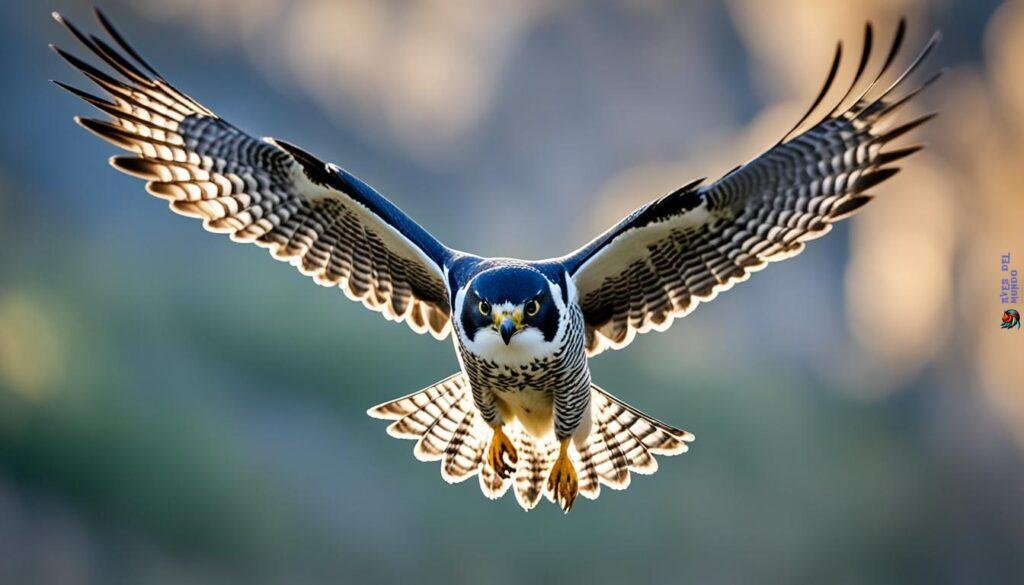
Peregrine falcons are often mistaken for sparrowhawks due to their similar size and shape. However, their unique markings, dark eyes, long wings, short tail, and distinctive call help differentiate them from other birds of prey.
Peregrine Falcon Speed
The peregrine falcon is renowned for its incredible speed and agility, making it one of the most formidable hunters in the animal kingdom. With its sleek and aerodynamic body, this majestic bird of prey can achieve remarkable speeds during its hunting maneuvers.
During a stoop, which is a high-speed dive used for hunting, the peregrine falcon can reach speeds of up to 242 mph (389 km/h). This astonishing velocity makes it the fastest recorded animal, unmatched in its ability to pursue and capture prey mid-flight.

The peregrine falcon’s exceptional speed is made possible by its physical adaptations. Its wings are long and pointed, allowing for efficient gliding and precise maneuverability. Additionally, its nostrils have special adaptations that enable it to breathe at high speeds without damaging its delicate respiratory system. These adaptations, combined with its mastery of flight, make the peregrine falcon an unrivaled aerial hunter.
When the peregrine falcon spots its prey from a distance, it initiates a rapid stoop, folding back its tail and wings to minimize air resistance. It tucks in its feet and plummets towards its target with incredible force and precision. At the last moment, it extends its talons to strike its prey, stunning or killing it for a successful hunt.
Witnessing the peregrine falcon’s lightning-fast speed in action is a true spectacle of nature’s prowess. Its ability to reach such astonishing velocities is not only a testament to its remarkable physical capabilities but also a testament to nature’s engineering marvels.
Peregrine Falcon Hunting Behavior
Peregrine falcons are formidable hunters, utilizing their unique hunting behavior to capture their prey. They are known for their exceptional speed, agility, and precision in the hunt. With their keen eyesight, the peregrine falcon primarily hunts at dawn and dusk, when their prey is most active.
The hunting technique employed by peregrine falcons is known as the stoop, a high-speed dive used to surprise and overtake their prey. It begins with spotting the prey from a distance, calculating the trajectory, and then folding back their tail and wings while tucking in their feet to streamline their body for maximum speed.
As they approach their prey, the peregrine falcons strike with incredible force, using their clenched foot to stun or kill their target. Remarkably, during the strike, they turn mid-air to catch their prey with exceptional precision. This swift maneuver allows them to maintain control and secure their catch even at high speeds.
If a peregrine falcon misses its initial strike, it will engage in a twisting flight to chase down its prey. Their agility and maneuverability are remarkable, enabling them to navigate through challenging aerial environments. While peregrine falcons primarily feed on pigeons due to their abundance in urban areas, they also hunt other bird species, especially during the migratory season.
Peregrine Falcon Hunting Behavior
| Hunting Behavior | Description |
|---|---|
| The Stooping Technique | A high-speed dive used to surprise and overtake prey |
| Precision Strike | Striking with a clenched foot to stun or kill the target |
| Mid-air Capture | Turning mid-air to catch the prey with exceptional precision |
| Twisting Flight | Chasing down prey in a twisting flight if the initial strike is missed |
Peregrine falcons’ hunting behavior demonstrates their remarkable adaptability and agility in capturing prey. Their hunting prowess and speed make them one of the most formidable avian predators in the world.
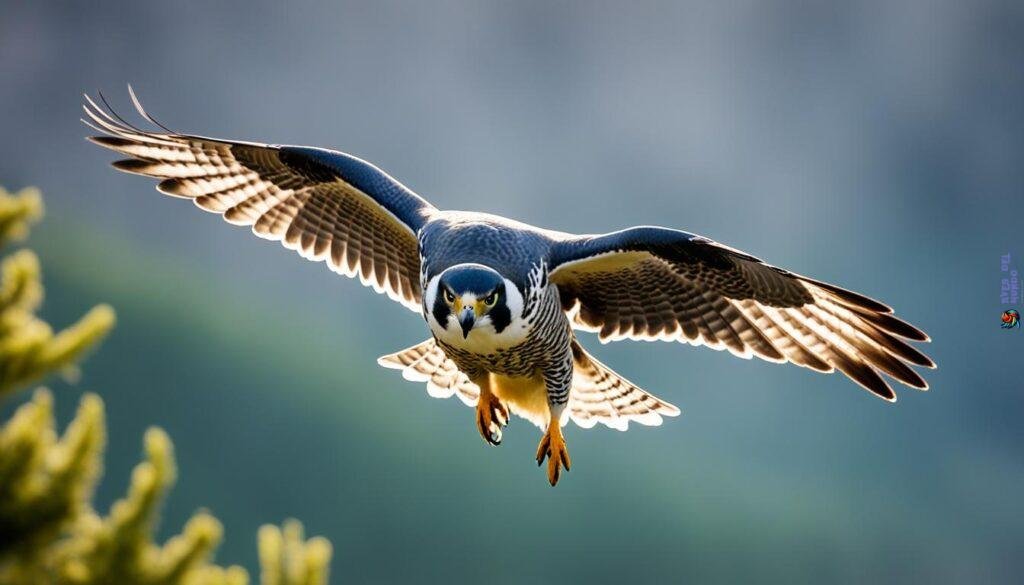
Peregrine Falcon Habitat and Nesting Habits
Peregrine falcons are known for their adaptability to various habitats, including both natural and urban environments. They prefer nesting in elevated locations, such as cliff edges or tall man-made structures like skyscrapers and industrial buildings. This unique nesting behavior has made them a successful example of urban wildlife.
These magnificent birds possess strong fidelity to their nesting sites. Once a pair has established a successful nesting site, they will return to it year after year. This behavior ensures familiarity and security for breeding and raising their young.
The female peregrine falcon typically lays up to five eggs in a nest known as a «scrape.» The scrape is a shallow depression on a ledge or other suitable surface that the falcons create by scratching and rearranging loose materials like rocks, gravel, or soil. Both parents take part in incubating the eggs, sharing the task of keeping them warm until they hatch.
After an incubation period of about 32 to 34 days, the chicks emerge from their eggs. Both parents continue to play a crucial role in nurturing and protecting the hatchlings. The chicks grow rapidly under the care of their attentive parents, nourished by a diet primarily consisting of freshly caught prey.
As the chicks mature, their flight feathers develop, and they strengthen their wings. After approximately 42 to 46 days, the young peregrine falcons become fully fledged and ready to leave the nest. This momentous stage marks the beginning of their independent life as skilled hunters.
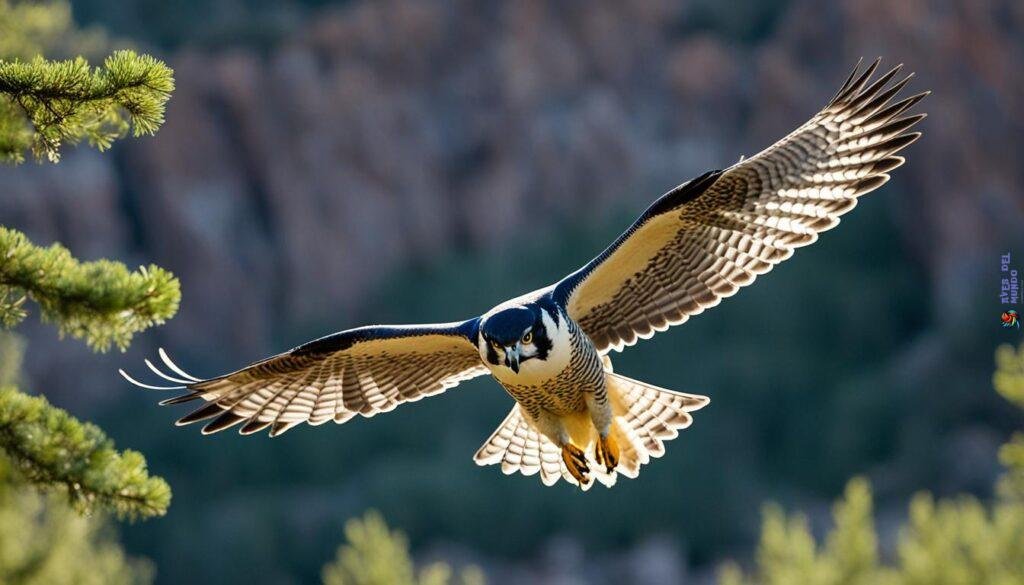
Peregrine Falcon and Wildlife Conservation
The peregrine falcon, renowned for its remarkable speed and hunting prowess, also holds significant conservation status. Classified as a protected species under The Wildlife and Countryside Act, the peregrine falcon has faced various threats in the past, including persecution and the harmful impact of pesticides, notably DDT.
Fortunately, through improved legislation and dedicated conservation efforts, the peregrine falcon population has experienced a noteworthy recovery. These conservation measures have played a crucial role in safeguarding the species and ensuring its survival in the wild. However, despite considerable progress, illegal killing and egg collection continue to pose ongoing threats to peregrine falcons.
Efforts are underway to combat these illegal activities and further enhance the conservation efforts for the peregrine falcon. By raising awareness about the importance of protecting this magnificent bird, promoting responsible environmental practices, and enforcing stricter regulations against illegal activities, we can strive to secure a brighter future for peregrine falcons and their habitats.
Conservation Status of Peregrine Falcons
The conservation status of peregrine falcons is of paramount concern due to their ecological significance and declining populations. The International Union for Conservation of Nature (IUCN) categorizes the peregrine falcon as a species of least concern, a testament to the success of conservation efforts.
However, despite their improved status, sustained conservation measures remain essential to ensure the long-term survival of these remarkable birds. Monitoring and protecting their nesting sites, raising public awareness, and promoting conservation initiatives are vital to maintaining the population stability and preserving the invaluable role peregrine falcons play in maintaining the delicate balance of ecosystems.
Together, through united conservation efforts and continued dedication to protecting the natural world, we can secure a future where peregrine falcons soar high and thrive in harmony with their surroundings.
| Threats | Conservation Efforts |
|---|---|
| Persecution | Improved legislation and enforcement |
| Pesticide Impact (DDT) | Ban on DDT usage and habitat restoration |
| Illegal Killing and Egg Collection | Law enforcement and public education |

Peregrine Falcon and Falconry Practice
Peregrine falcons are highly regarded in falconry practice due to their strong hunting abilities, trainability, and versatility. Their speed and agility make them effective at hunting game bird species. They are also popular subjects for wildlife photography, attracting photographers with their stunning aerial displays and hunting behaviors.
The Art of Falconry
Falconry, also known as hawking, is an ancient practice of training birds of prey to hunt game alongside humans. It is a unique and time-honored tradition that requires a deep understanding of these majestic birds and their hunting instincts. Peregrine falcons, with their exceptional speed and skill, have been prized in falconry for centuries.
Using trained peregrine falcons in falconry can be an incredible experience. Their remarkable hunting techniques and precision in targeting prey make them valuable partners for falconers. Peregrine falcons are known for their ability to perform stoops, reaching speeds up to 242 mph (389 km/h) as they dive towards their target. Their agility and strength enable them to catch elusive game birds, such as grouse and partridge, with remarkable efficiency.
Wildlife Photography and Peregrine Falcons
Peregrine falcons captivate wildlife photographers with their graceful flight and dynamic hunting behaviors. Photographers often seek opportunities to capture these birds in action, showcasing their incredible speed, agility, and power. Whether it’s a mid-air stoop or a precise strike, peregrine falcons provide thrilling moments for photographers to capture.
Wildlife photographers often spend hours observing peregrine falcons in their natural habitats, waiting for the perfect shot. Their stunning aerial displays and hunting prowess offer endless opportunities for visually striking and captivating photographs. Whether frozen in mid-air or soaring through magnificent landscapes, peregrine falcons make for extraordinary subjects in wildlife photography.
Falconry and Wildlife Conservation
Falconry not only serves as a recreational practice but also plays a role in wildlife conservation. Falconers work with conservation organizations to monitor and protect bird populations, contributing to research and conservation efforts. By raising awareness about birds of prey and promoting sustainable practices, falconry enthusiasts contribute to the conservation of peregrine falcons and other raptor species.
Through the combined efforts of falconers, conservationists, and photographers, the beauty and importance of peregrine falcons are brought to light. Their role in both falconry practice and the world of wildlife photography highlights the significance of protecting these magnificent birds and their habitats.
| Benefits of Peregrine Falcons in Falconry Practice | Significance in Wildlife Photography |
|---|---|
| Strong hunting abilities | Captivating aerial displays |
| Trainability and versatility | Dynamic hunting behaviors |
| Effective at hunting game bird species | Opportunities for visually striking photographs |
| Agility and speed during stoops | Showcasing the power and grace of flight |
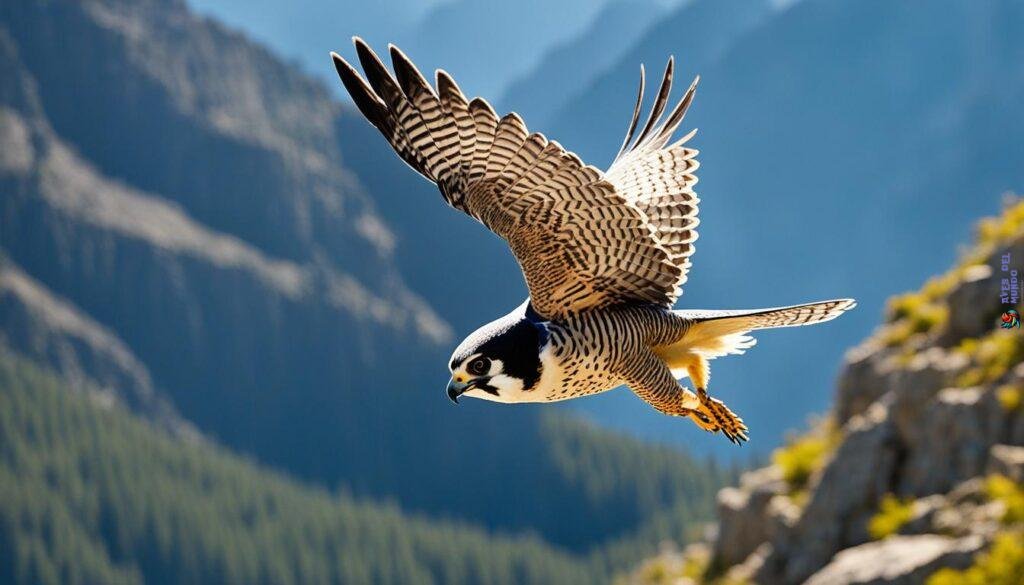
Peregrine Falcon and Jet Engine Design
Did you know that the peregrine falcon has influenced the design of jet engines? Scientists studying the peregrine falcon’s nostrils were inspired by their remarkable ability to breathe at high speeds without causing any damage.
The small cone-shaped structure in the bird’s nostrils served as the basis for the design of the cone in jet engines. This innovation allows for the efficient intake of air at great speeds, contributing to the overall performance and safety of jet engines.
This fascinating example demonstrates the significant influence of nature on human technology. By observing and understanding the adaptation of the peregrine falcon, scientists have been able to apply these principles to improve jet engine design.
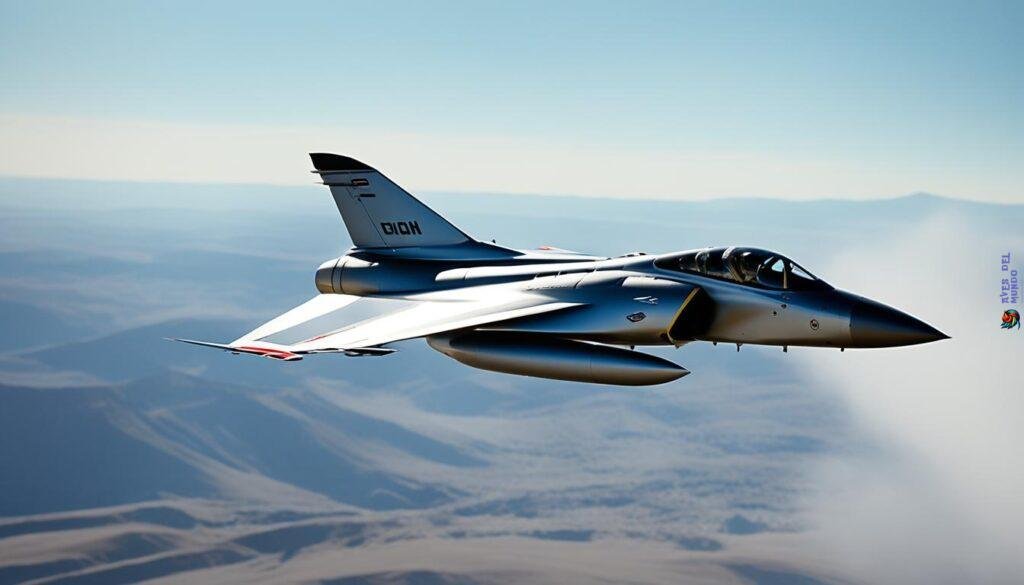
The peregrine falcon’s unique respiratory system has provided valuable insights for engineers and designers in the aeronautical industry. Nature continues to inspire and shape advancements in various fields, and the peregrine falcon’s influence on jet engine design serves as a testament to the symbiotic relationship between animal adaptations and human innovation.
Peregrine Falcon Courtship and Breeding
Peregrine falcons are known for their impressive courtship displays, which showcase their agility and aerial prowess. These courtship displays involve intricate aerial acrobatics, spirals, and steep dives. The falcons perform mesmerizing maneuvers in the air to attract and impress their potential mates.
During the courtship ritual, the male peregrine falcon passes prey to the female in mid-air. This act symbolizes his hunting prowess and ability to provide for their future offspring. It serves as a display of strength and bonding between the pair.
Once the mating pair has formed, peregrine falcons mate for life and exhibit strong fidelity to their nesting site. Every year, they return to the same location to breed, building on previous nesting successes and reaffirming their bond.
The responsibilities of caring for the eggs and raising the chicks are shared between both parents. The female lays up to five eggs in a scrape, and both parents take turns incubating the eggs until they hatch. After hatching, both parents actively participate in feeding and protecting the chicks.
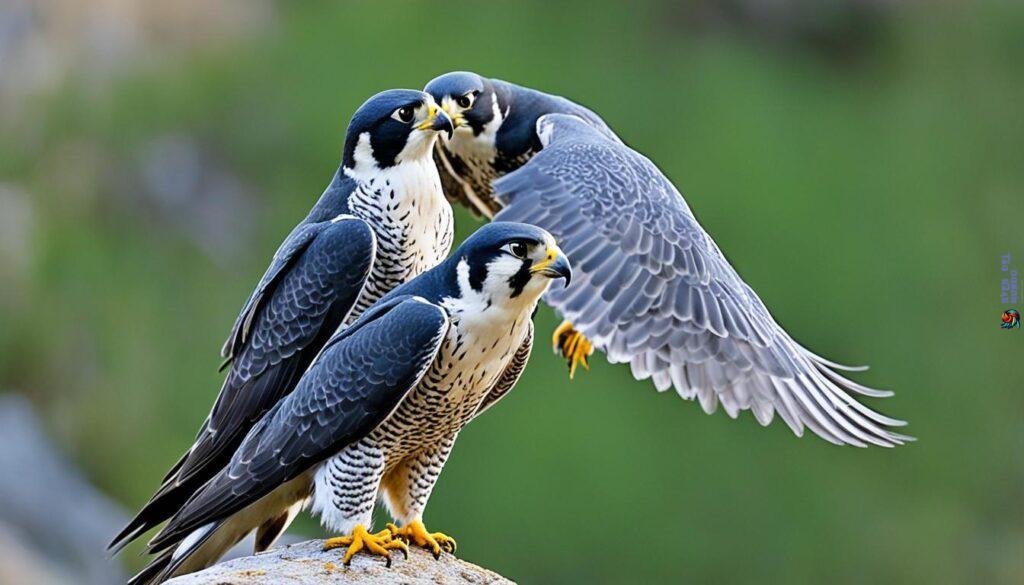
Fascinating Facts:
- Peregrine falcon courtship displays involve synchronized aerial acrobatics, with the male and female mirroring each other’s movements.
- The courtship flights can reach astonishing heights and speeds, highlighting the agility and precision of these birds.
- The male’s presentation of prey during courtship is seen as a demonstration of his hunting skills and ability to provide for the family.
- Peregrine falcons exhibit strong pair bonding and territorial behavior, defending their nest site fiercely.
- The courtship displays are not only a means of attracting a mate but also serve to strengthen the pair’s bond and communication.
The courtship and breeding behaviors of peregrine falcons showcase their commitment to each other and their offspring. These remarkable displays of courtship and shared parental responsibilities contribute to the survival and success of this magnificent species.
Peregrine Falcon and Recovery from Endangerment
The peregrine falcon population experienced a significant decline due to habitat loss, hunting, and the widespread use of the pesticide DDT. These factors led to a sharp decrease in their numbers, and the species was listed as endangered.
However, dedicated conservation efforts and various protective measures have played a crucial role in the recovery of the peregrine falcon population. One significant step was the ban on DDT, an insecticide that severely affected the falcons’ ability to reproduce and weakened their eggshells.
Additionally, reintroduction programs were undertaken to reintroduce captive-bred birds into suitable habitats. These programs aimed to increase the population and restore the falcon’s natural breeding and hunting behaviors. The efforts, combined with habitat conservation, monitoring, and public awareness campaigns, have resulted in a remarkable recovery of peregrine falcon populations.
Today, the peregrine falcon’s recovery is considered one of the major success stories in wildlife conservation. The decline of the population and subsequent recovery highlights the importance of preserving natural habitats and the need to address threats like habitat loss and the use of pesticides. It serves as a reminder of how human intervention and collective efforts can help protect and restore endangered species. With ongoing conservation measures, we can continue to ensure the peregrine falcon’s survival for future generations to marvel at their majestic beauty and remarkable hunting prowess.



